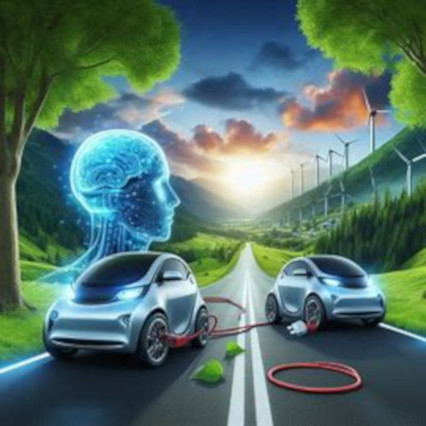Artificial Intelligence: Autonomous Driving
Artificial Intelligence (AI) has multiple applications including streamlining and enhancing business processes, medical diagnostics, manufacturing automation, text and image generation, and autonomous driving. Autonomous driving is an important AI application that will have a big impact on consumers in the coming years. These auto-driving AI systems may be seen as auto decisioning systems and the capabilities have now evolved to a point where they are being actively tested on roads now.
Autonomous driving AI uses video from the car’s cameras, light detection, GPS locations, range detection, infrared and sound sensors, location details, and road conditions as input to determine the proper driving operations. Autonomous driving AI, typically implemented as neural network models, use all the historical inputs available from past driving data, and simulations, to generate models which are then uploaded to automobiles to run in real time, as the car is in motion, which results in actionable decisions such as braking, accelerating and turning. The models also use route planning, the road, speed limits, conditions, the current state of the auto (speed & location) and other influences (other cars, pedestrians, intersections,…etc) to determine the best course of actions.
Self-driving adoption will take time and regulators will become increasingly involved. In addition, these AI systems need to be tested and evolve so both individuals (consumers) and government agencies become comfortable with the capabilities, implications and safety.
Autonomous Driving: Levels and Active Testing
Multiple levels of self-driving exist from adaptive cruise control and lane assist to self driving under certain conditions and locations with a driver present to full autonomous driving with no driver present (aka a Robo Taxi).
The autonomous AI models are built using past driving data captured as well as simulators as it would be too dangerous to let an EV AI system loose on the road to learn. If you are interested in learning more about the simulators a few open source options are available including Carla.org and deepdrive.io.
As of mid 2024, multiple companies are actively running and testing autonomous driving Robo Taxis including
- Waymo: Waymo, owned by Google parent Alphabet, currently operating in San Francisco and Phoenix with LA & Austin TX coming soon.
- Zoox: Amazon’s Zoox is testing fully autonomous cars with no drivers seat or driving wheel in the Las Vegas area.
- China is at the forefront of allowing autonomous driving and Baidu’s Apollo Go robotaxi has been active for a few years and is expected to become profitable in 2025.
- Tesla: Tesla recently received approval to test fully autonomous driving in Shanghai and Elon Musk has made it clear that a Tesla Robo Taxi is a high priority.
Autonomous Driving: The Benefits
The benefits of full self driving are well beyond assisting individuals in getting from point A to point B easier. It will take time but the benefits will include:
- Increased safety on the road: Not everyone is going to be willing to relinquish control of the car and that is fine. Regardless if all the full self-driving features are used, they may be activated at any time by the AI system to assist drivers in real time to help in situations such as spin-outs, oncoming cars going through a red light, and falling asleep at the wheel .
- Less Congestion: Human drivers create congestion, which will be minimized with self-driving systems, and eventually autonomous vehicles will be able to communicate with each other which will further increase safety and reduce congestion.
- Increased Productivity: In fully autonomous EVs, individuals may focus on personal and work tasks.
- Less Miles Driven & Reduced Consumer Cost: The ultimate vision for autonomous cars is that drivers will not be needed in many situations resulting in less miles driven and less need for cars for certain individuals.
- Increased Business Efficiency: With fully autonomous vehicles companies can run machinery (trucks, forklifts, etc) more often and at more efficient times.
- Additional Consumer Car Options: EVs and self driving will provide additional options to consumers and as more EVs are created, and the AI systems evolve, prices will decrease.
- Increased Transportation Options: Fully autonomous EVs will be able to run continuously when not being charged at a fraction of the cost of traditional Taxis. In addition, eventually the cost of taking autonomous EV ‘Ubers’ will be significantly less than owning a car for a portion of the driving population.
- Nature / The World: As EVs and AI evolve, and EVs and autonomous driving is further adopted, less fossil fuels will be used and less greenhouse gasses will be emitted.
EVs and More
EVs are a superior platform to implement these autonomous driving systems, compared to ICE vehicles, as EVs have the electric power available required to run the AI systems as well as to control the car – generate the route, auto brake, turn & accelerate. EV electric drivetrains also allow for enhanced tracking of all movements and actions and that data may then be used to continually enhance the AI systems.
Prices of EVs will continue to drop as automakers, especially traditional auto OEMs, complete their initial manufacturing investments and continue to learn how to create EVs more efficiently. EV battery prices will continue to drop as well with the advancement of current technologies and the rollout of newer EV battery options such as LFP and Sodium-ION.
I am not advocating that we should convert all transportation to electric and autonomous driving now or the foreseeable future as battery powered propulsion alone has its limitations and will not fully rid us of carbon-based transportation. Batteries are a great replacement for gas (and diesel) powered transportation in certain applications, including small to medium sized cars for certain individuals, but they have their limitations including in cold climates, towing and long-haul applications. Is there an option to replace gas powered vehicles in applications where EVs show limitations? Yes, Hydrogen Fuel cells which can incorporate these AI systems as well, but that is a topic for another day.
Conclusions
It will take time for individuals and government agencies to become comfortable with autonomous driving and it will also take time for the AI systems to become smart enough to take full control in all environments. The benefits will be realized over time as adoption and the strength of these AI systems evolve and converge. I may not see George Jetson flying cars in my lifetime but I am confident I will see many of the autonomous driving benefits listed above realized from EVs and AI. .

